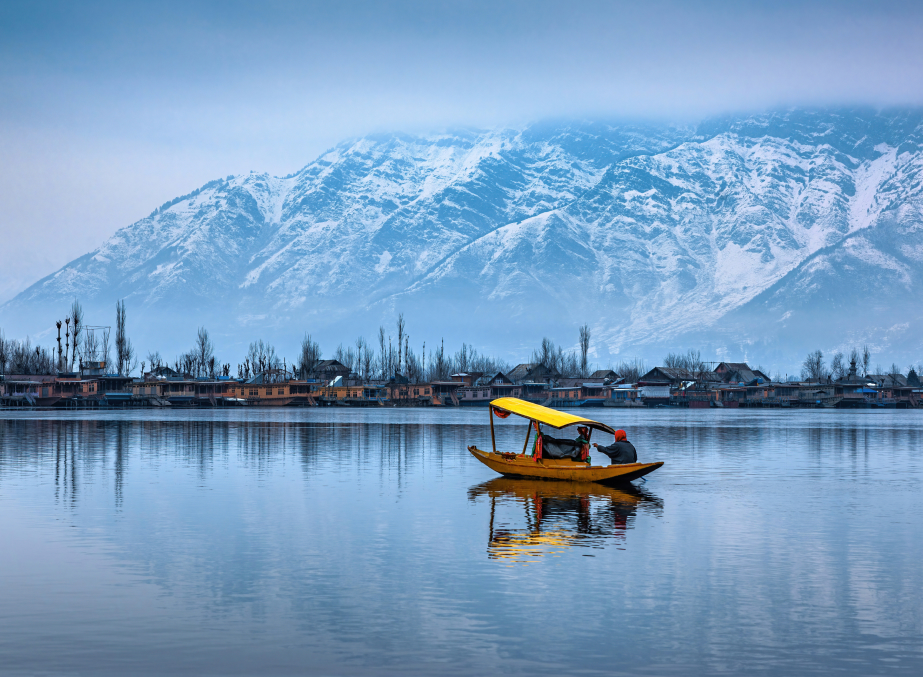Snow and Showers Revive Kashmir’s Winter Charm: A Comprehensive Overview
Srinagar 28 Feb 2025: After an extended dry spell that left Jammu and Kashmir grappling with a severe precipitation deficit, the recent wet spell has provided some much-needed relief. The overall shortfall has been reduced from 80 percent to 65 percent, thanks to the recent snow and rainfall. This revival of winter weather has brought hope to various sectors, including agriculture and tourism, while also presenting challenges.
Meteorological Department Forecast:
The latest forecast from the Meteorological Department indicates further improvements. Between February 27 and March 6, above-normal precipitation is expected, while near-normal precipitation is predicted between March 6 and March 13. However, meteorologists caution that while the situation has improved, it is still not enough to fully compensate for the prolonged dry conditions experienced since December 2023.
Impact on Agriculture:
The prolonged dry spell had significantly worried farmers, particularly apple growers, who rely on adequate snowfall to replenish soil moisture essential for horticulture. Farmers in Shopian, Pulwama, and Kulgam had expressed deep concern about potential crop damage due to the lack of snow, which affects both soil hydration and groundwater levels. The recent precipitation is expected to somewhat mitigate these concerns, providing relief to farmers who depend on winter snowfall for their crops.
Effects on Water Bodies and Hydropower:
The dry spell had also impacted water bodies across the region, reducing river and stream flows, and raising concerns about drinking water shortages in summer and the potential decline in hydroelectric power generation. The recent snowfall and rain have helped to alleviate some of these concerns, but the region still faces challenges in ensuring an adequate water supply for the coming months.
Tourism Sector Revival:
Kashmir’s tourism sector, heavily reliant on winter snowfall, had taken a hit due to the dry winter. Popular destinations like Gulmarg and Pahalgam received less-than-expected snowfall, leading to a drop in tourist numbers. However, the recent snowfall has revived hopes for the industry. Gulmarg, a prime winter sports destination, received 20 cm of fresh snow, offering a much-needed boost to winter tourism activities.
Disruptions and Challenges:
While the snowfall has been beneficial in many ways, it has also led to disruptions in various parts of the region. The Srinagar-Leh National Highway was temporarily closed due to heavy snowfall at Zojila Pass, where nearly 2 feet of snow accumulated. Sonamarg, another high-altitude area, recorded over a foot of snow, further affecting road connectivity. An avalanche in the Drass area also blocked a key route, prompting avalanche warnings from the district administration in Ganderbal.
In north Kashmir’s Kupwara district, heavy snowfall left several areas cut off from district headquarters, while power and water supply were disrupted. Residents in Handwara and Rajwar complained about uncleared roads, making travel difficult. Authorities have deployed men and machinery to clear the roads and restore essential services.
Rainfall and Urban Flooding:
In addition to snowfall, Jammu and Kashmir witnessed heavy rainfall in several regions, causing a significant drop in temperatures. Areas like Nowgam and Handwara recorded the highest rainfall at 46.6 mm, while Sopore, Bandipora, and Tangmarg also received substantial rain. However, heavy rains led to urban flooding in parts of Baramulla and Kupwara, where poor drainage systems worsened the situation. Baramulla’s major marketplaces, including Women’s College Road and Azad Gunj, were submerged, causing losses to shopkeepers and severe inconvenience to residents. Traders in Pattan and Kupwara expressed their frustration over inadequate drainage maintenance, calling for urgent intervention by municipal authorities.
Rejuvenation of Water Bodies:
The recent spell of precipitation has significantly reduced the rainfall deficit in Jammu and Kashmir, bringing much-needed relief to water bodies and glaciers. The deficit, which stood at 83 percent last week, has now dropped to 60 percent as of Thursday morning, marking a 23 percent improvement. According to meteorologists, the rainfall deficit is expected to decrease further, reaching 40 percent in Kashmir, 50 percent in Jammu, and 60 percent in Ladakh. The major precipitation recorded across the Kashmir division has brought the region’s overall rainfall deficit down to 63 percent.
“Although the deficit remains, it has improved from a large deficit category to a smaller one,” meteorologist Sonam Lotus told Greater Kashmir. In Jammu, significant rainfall has been recorded in the Pir Panjal and Chenab valley districts, including Doda, Ramban, Kishtwar, Rajouri, and Poonch, reducing the region’s rainfall deficit to 50 percent. However, other districts in Jammu continue to experience a substantial shortfall.
Ladakh has also witnessed major precipitation, particularly in Kargil and Zanskar, bringing the deficit down to 35 percent. However, Leh, Nubra, and Eastern Ladakh remain in the large deficit category, with shortfalls reaching up to 70 percent. Following a dry spell of 50 consecutive days at the start of 2025, Kargil has now received 17.4 mm of rainfall in the past 57 days, against a normal precipitation of 25 mm. Across Jammu and Kashmir, total recorded rainfall from January 1 to February 27 stands at 65.8 mm, compared to a normal of 215.5 mm.
Meteorologists said that while this wet spell has reduced the deficit, it has not completely compensated for the prolonged dry conditions. “The rainfall has helped reduce the deficit, but we still hope for more rains in March to further improve the situation,” Lotus said. Director of the Meteorological Department in Kashmir, Mukhtar Ahmad, told Greater Kashmir that the wet spell was more prominent in North Kashmir, with snowfall recorded in upper reaches.
Outlook for the Coming Weeks:
Weather experts predict an improvement in conditions starting February 28, with another brief spell of precipitation expected on March 3. However, from March 4 onwards, the weather is likely to remain mostly dry again. Experts believe that the fresh rainfall will rejuvenate water bodies across the region. “Every drop of rainfall is precious. This precipitation will help revive lakes, springs, streams, rivers, and, most importantly, glaciers,” Lotus said. He mentioned that alternating dry and wet spells are part of natural climatic variations and such fluctuations are witnessed periodically. The further replenishment of water sources will depend on the rainfall received in March. “Let us hope that it rains significantly in March too and the rainfall deficit is fully compensated,” Lotus added.
Education and School Reopening:
As schools in Kashmir are scheduled to reopen on March 1, the government is considering extending the winter vacation due to the cold weather and ongoing snowfall. If needed, the extension will apply primarily to primary and upper primary classes. This decision aims to ensure the safety and well-being of students during the harsh weather conditions.
Travel Advisory and Safety Concerns:
Authorities have warned of potential landslides, mudslides, and shooting stones in vulnerable areas, especially in Jammu and the Pir Panjal region. Travelers have been advised to exercise caution as certain roads may remain hazardous due to the ongoing weather conditions. The recent spell of snowfall and rain has provided much-needed relief by reducing the precipitation deficit, but the region still faces challenges, particularly in agriculture, water supply, and infrastructure.
Conclusion:
The recent snowfall and rain have revived Kashmir’s winter charm, providing much-needed relief to farmers, hoteliers, and local residents. While the region still faces challenges, particularly in agriculture, water supply, and infrastructure, the wet spell has eased concerns about water shortages and reinvigorated tourism and agriculture in Kashmir. Authorities remain on high alert, and the coming weeks will be crucial in determining whether the trend of improved precipitation continues.




